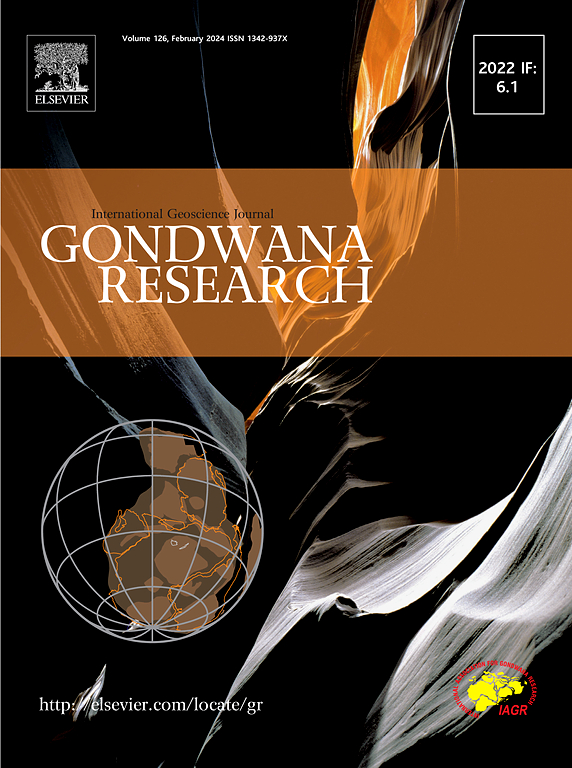晚三叠世恐龙的生物地理网络分析及其大地传播路径的新认识
IF 7.2
1区 地球科学
Q1 GEOSCIENCES, MULTIDISCIPLINARY
引用次数: 0
摘要
在过去的几十年里,恐龙古生物地理学一直是脊椎动物古生物学领域的一个引人注目的领域,尽管关于印度晚三叠世恐龙遗骸的研究很少或没有。本研究利用基于系统发育的网络分析,研究了早期恐龙的可能起源中心,包括晚三叠世的各种谱系,如蜥脚类、Herrerasauria和兽足类,特别强调了印度恐龙,包括从卡尼晚期到早/中诺里亚提基组发现的新骨骼元素。我们的系统发育研究将塔瓦定位为其他晚分化的Herrerasauria基部附近的Herrerasauria的姐妹类群,支持腔骨发育在新足类基部附近的位置,并提出了一些蜥脚类的替代位置。晚三叠世的恐龙网络,包括当代的蜥脚类恐龙和海龙,显示出几乎相同的拓扑结构,具有很强的互联性。基于网络分析,我们认为晚三叠世恐龙起源于南美洲,并有两条主要的扩散轨迹,同时到达了Laurasian和Gondwanan东部大陆。我们提出了一个新的模型,显示了南非和欧洲省之间更密切的动物关系,表明洲际动物交换和古迁移,特别是在蜥脚类动物进化的后期阶段。群落检测算法显示,印度晚三叠世恐龙组合与南美动物群具有更强的亲和力。因此,本研究强调了基于系统发育的网络分析在化石动物起源中心和传播路线推断中的重要性。本文章由计算机程序翻译,如有差异,请以英文原文为准。
Biogeographical network analysis of the Late Triassic dinosaurs and new insights on their geodispersal routes
Dinosaurian paleobiogeography has remained a compelling domain of interest in the field of vertebrate paleontology over the past few decades, though there has been little/no work with respect to the Late Triassic dinosaurian remains from India. This study investigates the probable centers of origin of the early dinosaurs that included various lineages such as Sauropodomorpha, Herrerasauria and Theropoda through the Late Triassic period using a phylogeny-based network analysis with especial emphasis on the Indian dinosaurs including the new skeletal elements recovered from the late Carnian to early/ middle Norian Tiki Formation of India. Our phylogenetic study positions Tawa as sister taxa to other late diverging herrerasaurids near the base of Herrerasauria, supports the placement of Coelophysis near the base of Neotheropoda and proposes alternative placements for a few sauropodomorphs. Networks of the Late Triassic dinosaurs including the contemporary sauropodomorphs and Herrerasauria exhibit nearly identical topologies with strong interconnectivity. Based on the network analysis, we propose South American origin for the Late Triassic Dinosauria with two primary dispersal trajectories leading to the Laurasian and Eastern Gondwanan landmasses simultaneously. We propose a new model that showed a closer faunal relationship between the South African and European provinces suggesting intercontinental faunal exchange and paleomigration particularly during the later stages of sauropodomorph evolution. Community detection algorithms revealed that the Late Triassic dinosaurian assemblage of India showed a stronger affinity with that of the South American fauna. Therefore, this study highlights the importance of phylogeny-based network analysis in the deduction of origination center and dispersal routes of the fossil animals.
求助全文
通过发布文献求助,成功后即可免费获取论文全文。
去求助
来源期刊

Gondwana Research
地学-地球科学综合
CiteScore
12.90
自引率
6.60%
发文量
298
审稿时长
65 days
期刊介绍:
Gondwana Research (GR) is an International Journal aimed to promote high quality research publications on all topics related to solid Earth, particularly with reference to the origin and evolution of continents, continental assemblies and their resources. GR is an "all earth science" journal with no restrictions on geological time, terrane or theme and covers a wide spectrum of topics in geosciences such as geology, geomorphology, palaeontology, structure, petrology, geochemistry, stable isotopes, geochronology, economic geology, exploration geology, engineering geology, geophysics, and environmental geology among other themes, and provides an appropriate forum to integrate studies from different disciplines and different terrains. In addition to regular articles and thematic issues, the journal invites high profile state-of-the-art reviews on thrust area topics for its column, ''GR FOCUS''. Focus articles include short biographies and photographs of the authors. Short articles (within ten printed pages) for rapid publication reporting important discoveries or innovative models of global interest will be considered under the category ''GR LETTERS''.
 求助内容:
求助内容: 应助结果提醒方式:
应助结果提醒方式:


